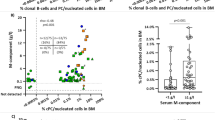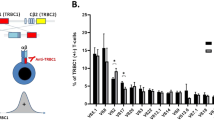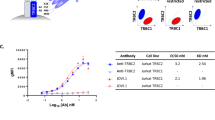Abstract
This study examines the identification of unusual cell populations highly associated with lymphoma cells (UCP-L) in diagnostic biopsy specimens using three-color flow cytometry (3-FCM). Patterns of surface antigen expression were used to compare the morphology of distinct lymphoid cell populations present in biopsy specimens and determine the presence or absence of UCP-L. UCP-L were identified by their larger size as compared to admixed reactive lymphocytes, and the method is based on the concept that neoplastic lymphoma cells are larger than reactive lymphocytes. The comparison of relative cell sizes was determined by overlaying forward scatter histograms by multicolor gating using PAINT-A-GATE software. In order for separate gates to be set on UCP-L and reactive cell populations, UCP-L had to fulfill one or more immunophenotypic criteria. These included: (1) belonging to a subset of B cell antigen-positive cells showing restricted expression of kappa or lambda light chains; (2) belonging to a subset of CD4-positive cells having dim or absent expression of CD45RA; (3) showing alterations in antigen expression (loss, dimmer or brighter); or (4) expressing an immunophenotype that is present on only rare cell populations or is absent from reactive lymph nodes. The immunophenotypic profiles of the respective cell populations were demonstrated by cubic representations to assess more easily the co-expression of three antigens. The common morphology of UCP-L as defined by forward and side scatter grams was consistent with a ‘lymphoid appearance’ except in several cases of HTLV-I-positive T cell lymphoma and γδ T cell lymphoma. The immunophenotypic profiles of UCP-L were confirmed to correspond to the presumptive lymphoma cell population by use of a live gating procedure on the large cells, which eliminated interference by reactive cells or necrotic tissue fragments. Using this method, we identified UCP-L in 208 of 293 (71%) consecutive cases of non-Hodgkin’s lymphomas, while no UCP-L were seen in 72 cases of non-specific hyperplasia of lymph nodes. Twenty-seven cases could not properly be examined about the existence of UCP-L because of massive necrosis, extensive fibrosis or strong non-specific staining reactions of unknown cause. When those cases were eliminated from the analysis, 80% of non-Hodgkin’s lymphoma were found to contain UCP-L. In B cell lymphoma, the incidence of UCP-L in nodal lymphomas (80%) was much higher than in extranodal lymphomas (47%). Only one of 21 cases of Hodgkin’s lymphoma was found to have UCP-L. The 3-FCM procedure was validated by the combined use of immunohistochemistry, morphologic examination, cytogenetic and antigen receptor gene rearrangement analysis by Southern blot hybridization. Our findings indicate that detection of UCP-L by 3-FCM is a reliable method to distinguish non-Hodgkin lymphomas from reactive hyperplasias in the majority of cases, even when the reactive cell population predominates over the malignant cell population.
This is a preview of subscription content, access via your institution
Access options
Subscribe to this journal
Receive 12 print issues and online access
$259.00 per year
only $21.58 per issue
Buy this article
- Purchase on Springer Link
- Instant access to full article PDF
Prices may be subject to local taxes which are calculated during checkout
Similar content being viewed by others
Author information
Authors and Affiliations
Rights and permissions
About this article
Cite this article
Ichinohasama, R., DeCoteau, J., Myers, J. et al. Three-color flow cytometry in the diagnosis of malignant lymphoma based on the comparative cell morphology of lymphoma cells and reactive lymphocytes. Leukemia 11, 1891–1903 (1997). https://doi.org/10.1038/sj.leu.2400802
Received:
Accepted:
Issue Date:
DOI: https://doi.org/10.1038/sj.leu.2400802
Keywords
This article is cited by
-
Utility of a new notation to visualize flow cytometry analysis results: first preliminary comparison with immunohistochemistry to detect CD30 expression on T-cell lymphoma cells
BMC Cancer (2021)
-
Ph-negative non-Hodgkin's lymphoma occurring in chronic phase of Ph-positive chronic myelogenous leukemia is defined as a genetically different neoplasm from extramedullary localized blast crisis: report of two cases and review of the literature
Leukemia (2000)



